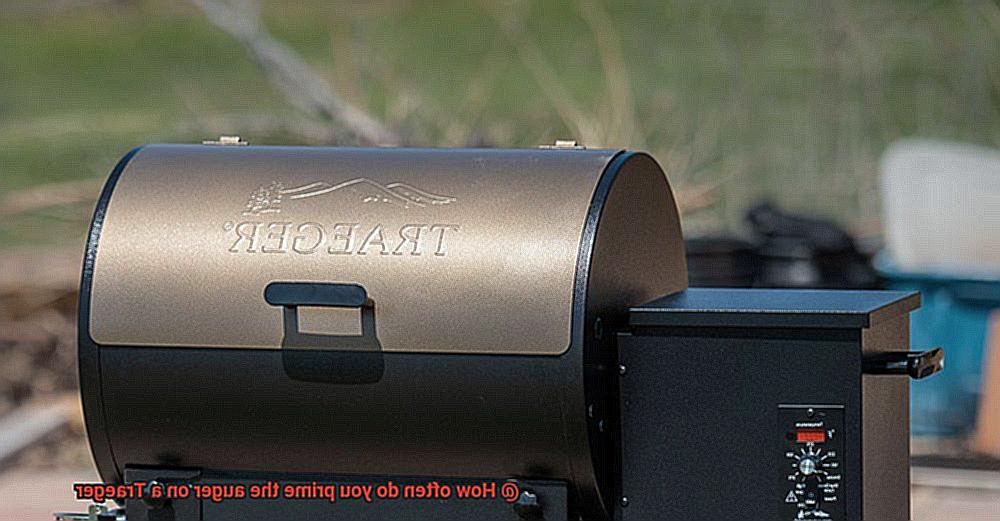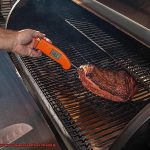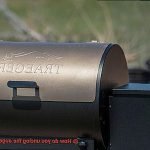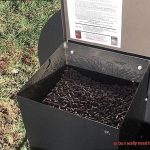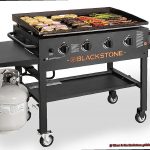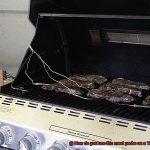Hey there, Traeger enthusiasts. Are you getting the most out of your pellet grill? If not, it could be because you’re neglecting one crucial aspect of maintenance: priming the auger. But don’t worry – you’re not alone in wondering how often to do this. It’s a question that stumps many grillers.
Some folks will tell you that the frequency of auger priming depends on how often you use your Traeger. Others swear by sticking to a set schedule, whether they’re grilling every day or just once a month. But what really matters is understanding why, when, and how to prime the auger for optimal performance.
That’s where we come in. In this article, we’ll delve into the nitty-gritty details of auger priming and explain everything you need to know about keeping your Traeger in tip-top shape. From the importance of regular maintenance to how often you should be priming the auger, we’ve got you covered. Don’t let your pellet grill go to waste – read on to become an expert on Traeger auger priming.
Contents
What is an Auger and Why Does it Need Priming?
Allow us to enlighten you. An auger is a vital component of your Traeger grill that feeds pellets into the firepot. It’s a long, spiral-shaped shaft inside the hopper that pulls pellets from the hopper and delivers them to the firepot. Without it, your Traeger wouldn’t be able to function properly.
To ensure that your Traeger grill runs smoothly and efficiently, it’s crucial to prime the auger regularly. Priming is the process of filling the auger with pellets and allowing them to flow through the system and reach the firepot. This ensures that there’s always a steady supply of pellets to fuel your grill and maintain a consistent temperature for your food to cook correctly.
The need for priming arises when you first set up your Traeger grill or when you run out of pellets. In both cases, there will be an empty space in the auger that needs to be filled with new pellets. Failing to prime the auger can result in uneven heating and problems with temperature control, which can adversely impact the quality of your food.
Priming is also essential in preventing jams in the auger. Jams occur when pellets get stuck in the system, causing blockages that can disrupt the flow of pellets and cause problems with your grill’s performance. By priming regularly, you can prevent these issues from occurring and ensure that your Traeger grill always runs smoothly.
So, how often should you prime your auger? Well, that depends on how frequently you use your Traeger grill and the type of pellets you’re using. As a general rule of thumb, it’s recommended that you prime your auger at the start of every grilling session. This ensures that there are no empty spaces in the auger and that your grill runs smoothly throughout the cooking process.
When you notice that your grill is not functioning correctly, or there are no pellets in the firepot, it’s time to prime your auger. To do this, turn off your Traeger grill and unplug it from the power source. Next, remove the hopper cover and vacuum out any excess pellets or debris. Use a long object like a wooden spoon or a cleaning rod to push any remaining pellets down into the auger. Finally, plug in your Traeger grill and turn it back on to resume grilling.
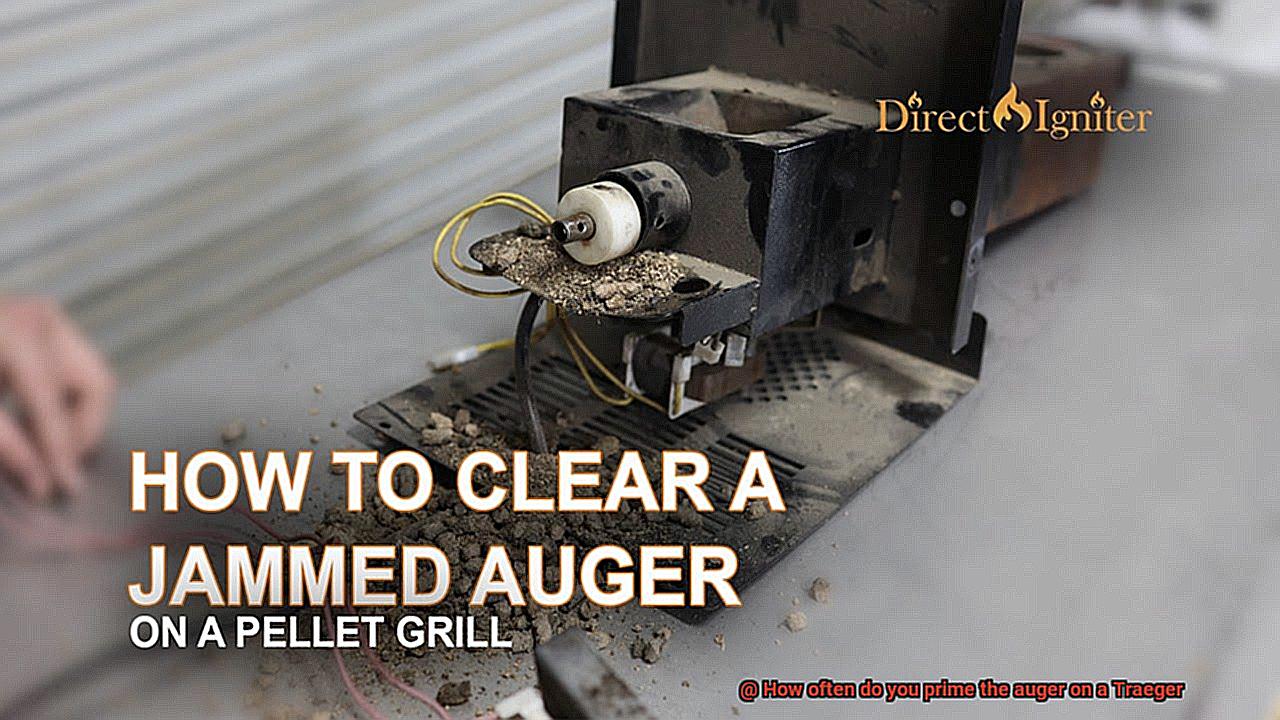
Factors That Affect How Often You Should Prime the Auger
The auger plays a pivotal role in the performance of your grill, responsible for feeding pellets to the firepot, and priming it regularly is crucial. However, there are many factors that can affect how often you need to prime the auger.
Firstly, the frequency of use is an essential consideration. If you’re someone who enjoys grilling frequently, you’ll need to prime the auger more often than occasional users. Frequent usage leads to more wear and tear on your grill, necessitating more maintenance.
Secondly, the type of pellets you use can make a difference. Pellets made from hardwoods like hickory or mesquite produce more ash and debris than other types of pellets. This buildup in the auger can lead to clogs and blockages, requiring more frequent priming.
Thirdly, cooking temperature also plays a critical role in determining how often you need to prime the auger. Even though high temperatures are great for cooking, they cause pellets to burn faster, leading to more ash and debris buildup in the auger.
Lastly, cleanliness is key when it comes to maintaining your Traeger grill. Failure to clean and maintain your grill properly can result in issues with the auger that require more frequent priming.
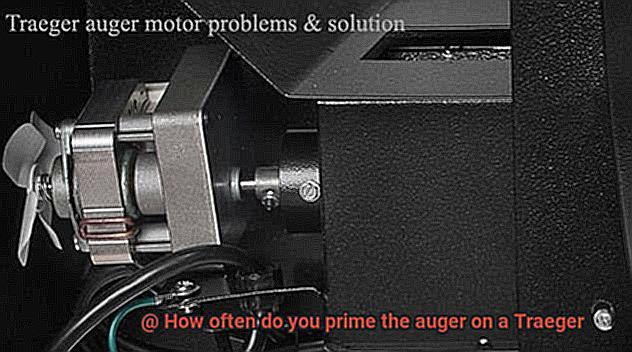
A General Rule of Thumb for Priming the Auger
Look no further than understanding the general rule of thumb for priming the auger. This simple step can make a world of difference in ensuring that your Traeger grill operates smoothly and produces delicious results every time you cook.
To begin with, it is recommended to prime the auger at the start of each grilling session. By doing so, you allow the pellets to feed properly into the firepot, which helps the grill reach and maintain the desired temperature. However, if you’re cooking for an extended period, it may be necessary to prime the auger again halfway through the cooking time. This is especially important if you’re smoking a brisket or ribs for 12 hours or more. By priming halfway through, you can prevent any potential issues with pellet feed and ensure that the temperature remains consistent throughout the cooking process.
It’s also worth noting that outdoor temperature and humidity can affect how often you need to prime the auger. In colder temperatures or high humidity, pellets may stick together and cause feeding issues. Therefore, it’s essential to prime more frequently to ensure proper pellet feed in these cases.
In addition to these factors, it’s essential to consider the type of pellets you’re using. Different types of pellets may have different feeding characteristics, so be aware of how your pellets behave. For example, fruitwood pellets tend to have a higher moisture content than other types, which can affect feeding rates.
To sum it up, here are some sub-topics and lists that you should keep in mind when priming your Traeger grill’s auger:
- Frequency of priming: Priming should be done at the start of each grilling session, but if you’re cooking for an extended period, prime halfway through.
- Outdoor temperature and humidity: In colder temperatures or high humidity, pellets may stick together, causing feeding issues. Prime more frequently in these conditions.
- Pellet type: Different types of pellets may have different feeding characteristics, so be aware of how your pellets behave.
Step-by-Step Instructions for Priming the Auger
Before you do, it’s important to make sure that the auger is properly primed and ready to feed pellets into the firepot. As an expert on the topic, I’m here to guide you through the step-by-step instructions for priming the auger on your Traeger grill.
Step 1: Turn on and Set to Smoke
The first step is to turn on your Traeger grill and set it to the smoke setting. This allows pellets to start moving through the auger.
Step 2: Add High-Quality Wood Pellets
Next, open the hopper lid and add high-quality wood pellets, specifically designed for pellet grills. Low-quality pellets or those filled with additives can damage your grill and negatively impact the flavor of your food.
Step 3: Wait for Pellets to Start Moving
Once you’ve added your pellets, close the hopper lid and wait for them to start moving through the auger. This may take a few minutes, so be patient.
Step 4: Prime the Auger
When you see pellets moving through the auger and into the firepot, it’s time to prime the auger. Simply press and hold the Prime button on your Traeger controller. This will force pellets into the firepot and ignite them, creating a flame. Keep holding down the Prime button until flames come out of the firepot.
Step 5: Set Your Desired Temperature
Once flames are coming out of the firepot, release the Prime button and set your Traeger controller to your desired temperature. Your grill is now fully primed and ready for use.
Remember, you only need to prime your Traeger auger once per cooking session. If you find that you need to prime it multiple times or experience issues with pellet flow, there may be an underlying issue with your grill that requires maintenance or repair.
Preventative Maintenance Tips to Keep Your Traeger Working Properly
One of the most important things you can do is regularly prime the auger. In this article, we’ll discuss why it’s important to prime the auger and how to do it properly.
Why Should You Prime Your Auger?
The auger is responsible for delivering pellets from the hopper to the firepot, where they’re burned to create heat and smoke. A well-functioning auger ensures that your grill is cooking at the desired temperature and producing delicious food. By regularly priming your Traeger’s auger, you can prevent blockages or jams that can cause issues with temperature and cooking performance.
How To Prime Your Auger
To prime your auger, start by turning on your Traeger and setting it to smoke mode. Wait for it to warm up before turning it off and unplugging it. Then, remove the grates and drip tray to access the firepot. Take a small brush or vacuum to clean out any ash or debris in the fire pot and surrounding area.
The next step is to remove the hopper lid and pour in a small amount of pellets. Plug in your Traeger and turn it on to the desired temperature. This will start the auger spinning and feeding pellets into the fire pot. Once you see pellets start to fall into the fire pot, turn off your Traeger and unplug it again.
Repeat this process until you see a steady stream of pellets falling into the fire pot without stopping or slowing down. It’s recommended to prime the auger every 3-5 uses or at least once a month, depending on usage.
Other Preventative Maintenance Tips
In addition to regularly priming your Traeger’s auger, it’s important to clean the grill regularly. This includes removing any buildup of ash or grease from the firepot, drip tray, and grates. A buildup of debris can cause issues with temperature control and lead to uneven cooking.
It’s also important to inspect and replace parts as needed. This includes checking the condition of the auger motor and fan blades, as well as replacing any worn or damaged parts.
Common Issues That Can Occur If You Don’t Prime the Auger Regularly
Well, if you neglect to prime the auger regularly, your grilling experience may not be as delightful as you’d like. Failing to do so can cause several issues that can affect the performance of your grill and the taste of your food.
Firstly, poor temperature control is a common problem caused by an unprimed auger. Uneven feeding of pellets into the firepot can result in inconsistent temperatures and cooking times. This can lead to overcooked or undercooked food, which is not what any grill master desires.
Secondly, a neglected auger can cause a buildup of ash and debris in the firepot, clogging its holes. This blockage can prevent air from flowing through and cause the fire to go out. Not only will this ruin your meal, but it can also produce more smoke than usual and negatively impact the flavor of your food.
Furthermore, failing to prime your auger regularly can cause damage to the motor that powers it. The motor may have to work harder to push pellets through an unprimed auger, leading to overheating and eventual failure. A broken grill is not only frustrating but also costly to repair or replace.
To avoid these issues, Traeger recommends priming the auger before every use, especially if your grill has been sitting idle for a while. By turning on the grill and allowing it to run for a few minutes before adding food, you’ll ensure even feeding of pellets into the firepot and consistent temperature control throughout the cooking process.
How to Troubleshoot Problems With Your Traeger’s Auger
Grilling on a Traeger is an art form, and the auger is a critical component in the process. However, issues with the auger can lead to poorly cooked food or even ruin your grilling experience. Here are some steps you can take to troubleshoot common problems with your Traeger’s auger:
Priming the Auger
Priming the auger is essential to start your Traeger and ensure that it functions correctly during grilling sessions. If you’re having difficulty maintaining temperature or feeding pellets, it may be time to prime the auger manually. First, turn off your Traeger, unplug it, and remove the hopper cover. Then use a long tool like a screwdriver or wooden spoon to turn the auger manually, ensuring that pellets are being pushed through.
Clogging
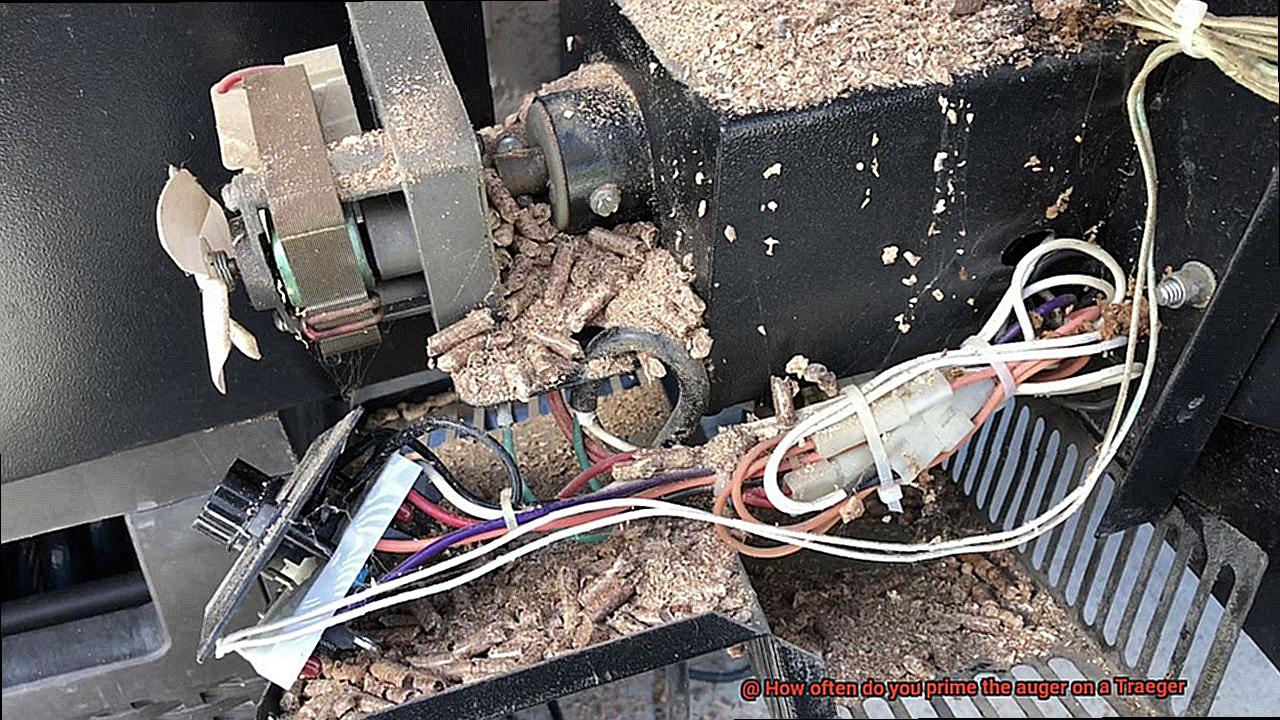
Clogging is a common problem that can affect your Traeger’s auger and can be caused by pellets that are too long or too wide, debris in the pellets, or moisture in the pellets. To resolve this issue, turn off your grill and unplug it before inspecting the hopper and auger for any obstructions. Gently remove any obstructions using a brush or vacuum.
Misfeeding
Misfeeding happens when pellets don’t enter the auger properly, leading to poor combustion and an uneven temperature in your grill. To fix this problem, check the hopper for any obstructions and ensure that the pellets are loaded correctly. You should also examine the auger for any damage or wear and tear that could affect its performance.
Auger Not Turning
If your Traeger’s auger isn’t turning at all, you may need to check the motor and wiring connections. Turn off your grill and unplug it before inspecting these components for any loose connections or damaged wires that need replacing. If you’re not comfortable doing this yourself, it may be best to contact customer support or schedule a repair appointment.
Regular Cleaning
To prevent any build-up of debris or pellets in the auger, it’s crucial to clean your Traeger regularly. This will help ensure that your Traeger continues to function correctly and produce deliciously cooked food every time you use it. Always remember to follow the manufacturer’s instructions when cleaning your Traeger.
gQozRCO8mi8″ >
Also Read: How to Charge the Auger on a Traeger Grill
Conclusion
In summary, priming the auger on your Traeger grill is a vital maintenance task that can have a significant impact on your food’s taste and quality. The auger plays a crucial role in feeding pellets into the firepot to regulate temperature and prevent blockages that can lead to poor combustion.
It’s recommended to prime the auger before every grilling session, but various factors like usage frequency, pellet type, and outdoor conditions can affect how often you need to do it. To ensure optimal performance, regular cleaning and maintenance are essential. This includes inspecting parts for wear and tear, clearing out debris from the firepot and surrounding areas, and only using high-quality wood pellets designed for pellet grills.
If you neglect to prime your Traeger’s auger regularly or experience issues with feeding pellets or maintaining temperature control, troubleshooting steps such as manually priming the auger, checking for clogs or misfeeding, examining motor connections or contacting customer support may be necessary.
Ultimately, by understanding why and how to prime your Traeger’s auger correctly and taking preventative measures to maintain your grill’s components regularly, you’ll enjoy consistently delicious meals every time you fire up the grill.

